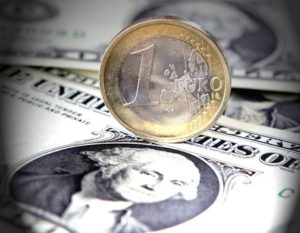 The euro declined against the US dollar, as the German top court announced it will not decide on the legality of the ECB bailout plan and will transfer it to Europes highest judges.
The euro declined against the US dollar, as the German top court announced it will not decide on the legality of the ECB bailout plan and will transfer it to Europes highest judges.
EUR/USD hit a session low at 1.3553 at 08:35 GMT, after which consolidation followed at 1.3565, losing 0.19% on a daily basis. Support was likely to be received at February 6th low, 1.3483, while resistance was to be encountered at February 6th high, 1.3619.
The euro came under selling pressure after the German Federal Constitutional Court said today it will ask the European Court of Justice to decide if the ECB overstepped its powers back in September 2012, when it announced the Outright Monetary Transactions (OMT) bond-buying program. The program has not been used so far, but it was initially created to authorize the central bank to buy bonds of indebted countries. The OMT program is said to have helped in easing borrowing costs, which reached record-highs.
“It’s a clear euro negative if you’re questioning the whole legality of the existing framework of the OMT program,” said Carl Hammer, a currency strategist at SEB AB in Stockholm, cited by Bloomberg. “The program has had a material effect in lowering the risk premia in European assets, which had supported the euro.”
Yesterday, the ECB President Mario Draghi refrained from taking action to counter low inflation, but said that the central bank is ready to intervene as soon as next month, when more euro zone data will be available.
“We are willing and we are ready to act,” Draghi said yesterday in Frankfurt, cited by Bloomberg. His comments came after the ECB left its benchmark interest rate at a record-low 0.25%. He also added: “The reason for today’s decision not to act has really to do with the complexity of the situation that I described and the need to get more information.”
Draghi also reiterated the forward guidance of the central bank, that rates will be kept at their current record levels, or even weaker, for a prolonged period of time.
He tries to guide the euro zone through fragile economic recovery as inflation remains at the lowest since 2009. For now, interventions are postponed at least until next month, when the central bank is going to publish its quarterly macro-economic forecasts, which will provide first inflation prediction for 2016. Previous forecasts have revealed that the ECB should take more decisive steps and should further ease its monetary policy.
Inflation in the euro area sharply declined to an annualized pace of 0.7% in January, the weakest level in four years and after a 0.8% increase in the previous month. Analysts had estimated that consumer prices will increase by 0.9% in January. This was a fourth straight reading of inflation under 1%, which was referred to by ECB President Mario Draghi as a danger zone. The central bank attempts to maintain inflation at just below 2%, which added to concerns over the threat of deflation in the region.
Inflation in Germany, the largest economy in the euro bloc, unexpectedly remained steady at 1.2% in January, defying analysts projections of an increase to 1.3%. This data came as another evidence of weak price pressure in the 18-nation common currency area.
The low inflation rate in the euro zone was mainly driven by a 1.2% slump in energy prices, Friday’s report showed. Core consumer prices, which exclude volatile items such as energy, tobacco and alcohol, however, increased by 0.8% this month, after a 0.7% advance in December.
The unemployment rate in the euro area remained unchanged at 12% in December, after November’s reading has been revised down to 12.0% from 12.1% previously. The unemployment rate eased a bit from September’s high of 12.1%.
However, some economic indicators showed improvement as German business confidence and euro-area manufacturing rose to the highest in more than two years. In addition, the euro zone composite output index advanced in January, and data showed the gain was mainly driven by growth in the manufacturing sector, where the increase in total new orders and new export business helped production to reach its highest level in almost three years.
Meanwhile, greenbacks demand came under pressure, following a report by the US Bureau of Economic Analysis, which revealed that nation’s trade deficit widened to 38.7 billion USD in December from 34.25 billion USD during the preceding month. Analysts had forecast that the deficit figure will widen at a lesser pace to reach 36 billion USD.
However, the number of initial jobless claims in the United States came in at 331 000 during the week ended February 1st, down from 348 000 in the previous week and less than expectations of 335 000 more people, who filed for unemployment assistance.
The Department of Labor in the country may report that non-farm payrolls increased by 183 000 in January, after in December US employers added 74 000 jobs, or the smallest change since January 2011.
The rate of unemployment, at the same time, is expected to remain steady at 6.7% in January. The official figures are to be released at 13:30 GMT today.
On Wednesday Automatic Data Processing Inc. (ADP) said that nation’s private sector added 175 000 new job positions in January, below expectations that jobs may grow by 189 000. In December economy managed to add 227 000 jobs.
Elsewhere, GBP/USD hit a session low at 1.6303, after which the pair advanced 0.08% to trade at 1.6336 at 10:10 GMT. Support was likely to be received at February 6th low, 1.6273, while resistance was to be encountered at February 3rd high, 1.6438.





